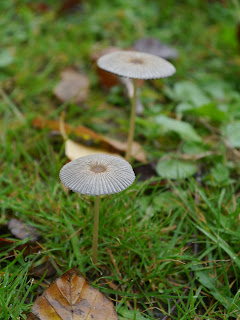Yes, autumn is very much upon us - although the leaves are only beginning to change, the fungi have burst out of the ground/wood, bolstered by the wet weather we've been having.
Having visited Langley Wood last month to check on the chestnuts (not yet ready) and the fungi (ditto), I put it down to the dry weather. Now, having visited various New Forest ancient woodlands, and a quick foray to Purbeck to visit family, the great diversity of fungi is very much on display.
My favourite is a beautiful mushroom called a 'bolete' - this large and distinctive family are short, fat, and often interestingly coloured, with no gills under the cap - only pores. This particular one is - we think - Boletus luridus. However, my mushroom book dates from 1981 so I feel mycology may have moved on a bit since then! We first found this gorgeous species in Eyeworth wood in the New Forest, but we also found one growing beside the main track in Grovely Wood, and a lovely large one in Mark Ash Wood (New Forest again). Having never seen any like this before, there is speculation that the dry summer followed by late wet conditions, may result in some rare fungi making an appearance. Could this be the reason for spotting it?
Although a lot are edible, collecting of fungi is strictly forbidden in the New Forest, as they are one of the reasons the site is legally protected and internationally important for wildlife. What we often see is the fruiting body of the much larger subterranean organism, producing spores to spread far and wide in the woodland, so collecting these could reduce the numbers seen in the future. Many fungi are associated with particular species of tree, forming 'mycorrhizae' with the tree's roots, forming a sort of nutrient swap benefiting both.
I much prefer to take a few pics (OK, a lot of pics) and leave for others to enjoy. So if you see anyone picking them, let the Forestry Commission know.
























No comments:
Post a Comment